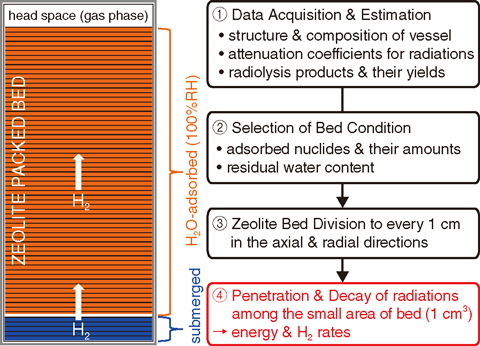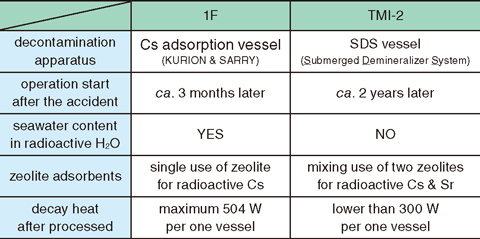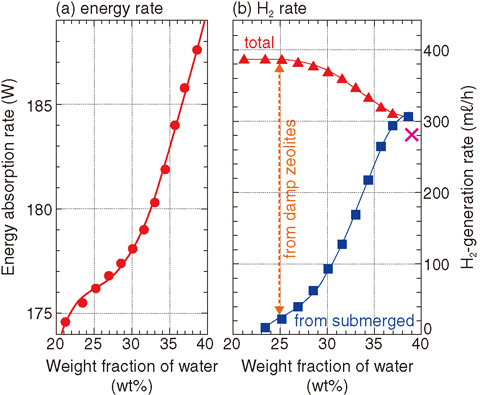
Fig.1-45 Schematic distribution of residual water and the estimation procedure for H2-generation in spent adsorption vessels
Table 1-2 Decontamination of radioactive water after the accidents at 1F and TMI-2


Fig.1-46 A typical example of estimated rates of energy-absorption (a) and subsequent H2-generation (b) in the spent SDS vessel
To attain long-term safe storage of spent Cs adsorption apparatuses (KURION and SARRY) with zeolite adsorbents used in the decontamination of radioactive water emitted after the accident at the TEPCO’s Fukushima Daiichi NPS (1F), energy-absorption of radiations from radioactive nuclides adsorbed onto the zeolites, as well as subsequent H2-generation by water radiolysis in the adsorption vessels, have been estimated on the basis of the latest experimental data obtained from adsorption and radiolysis occurring in “small-scale” zeolite-water mixtures. This was done using the estimation procedure (1) to (4) illustrated in Fig.1-45.
Two years after Three Mile Island Unit 2 (TMI-2) accident in 1979, radioactive water without seawater content had been processed through a Submerged Demineralizer System (SDS) with two types of zeolites to remove radioactive nuclides of Sr, Cs, and their daughter nuclides (Table 1-2). During and after this process, H2-generation was monitored directly in the “large-scale” of a spent SDS vessel, together with the amount of adsorbed nuclides and the residual water content (whose measured and analyzed data are open and available in reports) as well as the size and geometry of the vessel.
In this work, the re-estimation of H2-generation in spent SDS vessels from the TMI-2 accident was conducted on the basis of publicly available information about the vessel, and of the latest experimental data from small-scale zeolite-water mixtures like in the spent vessels from the 1F accident. The latest estimated data was compared with that previously reported.
A typical example of the estimated results is shown in Fig.1-46. The energy rate (a) absorbed in the vessel increased with increasing water content and was found to be 74%-84% of the decay heat, of which the rest was given to SUS and leakage out of the vessel. According to the H2-generation rate (b) obtained from the energy rate, the partial rate at the submerged part of the zeolite bed increased with increasing water content, while the total rate decreased, leading to a “liquid depth effect” corresponding to the size effect of the bed. Directly monitored H2 data has been reported for the completely submerged condition of the bed, and the reported data (![]() in Fig.1-46) was found to agree well with the estimated one in this work.
in Fig.1-46) was found to agree well with the estimated one in this work.
Finally, the estimation method for H2-generation in spent vessels from “small-scale experiments” performed in this work was validated. To estimate this generation more accurately, the temperature distribution of the spent zeolite bed because of its long-term storage, and radiolysis behavior in complicated systems containing solids and/or solutes are being further studied.